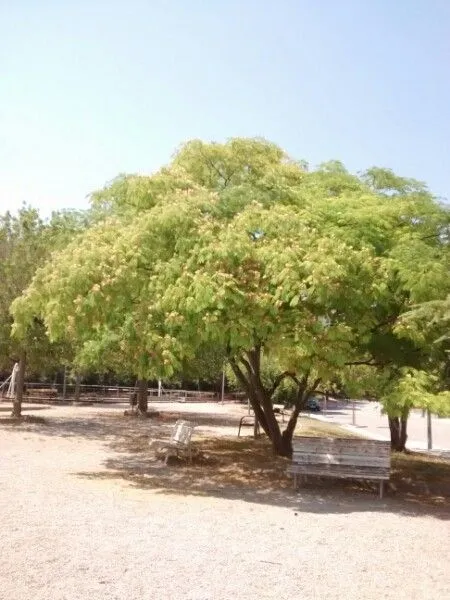
Author: Durazz.
Bibliography: Mag. Tosc. 3(4): 11 (1772)
Year: 1772
Status: accepted
Rank: species
Genus: Albizia
Vegetable: Unknown
Observations: E. Transcaucasus to Japan
Mimosa, scientifically known as Albizia julibrissin, is a remarkable member of the Fabaceae family. First described by Durazz. in the “Mag. Tosc.” in 1772, the Mimosa tree captures the imagination with its unique beauty and fascinating botanical characteristics.
Native to a geographical stretch spanning from Eastern Transcaucasus to Japan, the Mimosa tree thrives in a variety of climates. This adaptability has allowed it to become a beloved ornamental plant in gardens across the globe. Mimosa trees are especially renowned for their delicate, fern-like leaves which are made up of numerous tiny leaflets. These leaves close up when touched, a phenomenon known as thigmonasty, which adds an interactive element to the plant’s allure.
The Mimosa tree is also celebrated for its showy, fragrant flowers which bloom in the summer. The blossoms are arranged in fluffy, pom-pom clusters often in shades of pink, lending a delicate, airy texture to the landscape. These flowers not only enhance visual appeal but also attract pollinators such as bees and butterflies, contributing to the local ecosystem.
In addition to its ornamental value, the Mimosa has practical applications in various traditional medicines across its native range. It is valued for its purported anti-inflammatory and analgesic properties, and various parts of the tree are used in different preparations to treat a range of ailments.
Despite its beauty, the Mimosa can be somewhat of a double-edged sword in regions outside its native habitat. In certain areas, it is considered invasive, due to its rapid growth and the ability to outcompete native plants. This characteristic necessitates mindful cultivation and management to prevent potential ecological imbalance.
In summary, the Mimosa or Albizia julibrissin stands as a testament to nature’s intricate beauty and resilience. Whether admired for its ornamental quality, its intriguing botanic responses, or its uses in traditional medicine, this tree holds a special place in the plant kingdom. Its history and characteristics encourage a deeper appreciation of the diverse forms life has taken on our planet.
Deu: federbaum, gewöhnliche albizzie, schirmakazie, schlafbaum
Ita: gaggia arborea
Eng: silktree, mimosa, mimosa-tree, pink siris, powderpuff tree, silk tree, silktree albizia, siris, varay-cotton, persian silk tree
Por: acácia-de-constantinopla, acácia-de-constantinópola
Fra: arbre de soie
Hun: perzsa selyemakác
Afr: plenk siris, syboom
Swe: silkesträd
En: Mimosa, Mimosa-tree, Silktree, Silktree albizia, Pink siris, Varay-cotton, Siris, Silk tree, Powderpuff tree, Mimosa Tree, Persian Acacia
Af: Plenk siris, Syboom, Pienk albizia
Ar: ألبيزيا زهرة الحرير
Hy: Ալբիցիա լենքորանյան
Az: Lənkəran güləbrişini
Eu: Konstantinoplako akazia
Bg: Юлибрисинова албиция
Ca: Acàcia taperera
Zh: 合欢, 合歡
Cs: Albízie růžová, Albízie
Nl: Albizia
Eo: Persa silka arbo
Fi: Silkkialbitsia
Fr: Arbre de soie, Albizia, Arbre à soie, Mimosa de Constantinople, Acacia rose de Constantinople, Acacia de Constantinople
Gl: Árbore da seda
Ka: Აბრეშუმა აკაცია
De: Schirmakazie, Schlafbaum, Federbaum, Seidenbaum, Gewöhnliche Albizzie
El: Ακακία Κωνσταντινουπόλεως
Hu: Perzsa selyemakác
It: Durazzo, Gaggea arborea, Gaggia arborea, Acacia di Constantinopoli, Albizzia
Ja: Nemu-no-ki
Ko: Jagwinamu, 자귀나무
Ne: रातो शिरिष
Fa: شبخسب
Pl: Albicja jedwabista
Pt: Albízia-de-Constantinopla, Acacia nemu, Acácia-de-constantinopla, Acácia-de-constantinópola
Pt-br: Albízia, Acacia nemu
Ru: Альбиция ленкоранская
Sr: Свиласта албиција
Es: Acacia de Persia, Acacia de Constantinopla, Árbol de la seda
Sv: Silkesträd
Zh-tw: 合歡
Tt: Ефәк сәрви агачы
Zh-hant: 合歡
Tr: Gülibrişim
Uk: Альбіція іранська
Taken Jul 30, 2018 by Pep Secem (cc-by-sa)
Taken Jul 18, 2018 by Dieter Wagner (cc-by-sa)
Taken Jul 30, 2018 by Pep Secem (cc-by-sa)
Taken Jul 9, 2019 by Manu Pacha (cc-by-sa)
Taken Jul 9, 2019 by Manu Pacha (cc-by-sa)
Taken Jul 30, 2018 by Pep Secem (cc-by-sa)
Taken Aug 12, 2019 by u floren (cc-by-sa)
Taken Jun 22, 2021 by Mrc Pase (cc-by-sa)
Taken Jul 9, 2019 by Manu Pacha (cc-by-sa)
Taken Jul 30, 2018 by Pep Secem (cc-by-sa)
Taken Sep 27, 2019 by Dieter Wagner (cc-by-sa)
Taken Jan 1, 1900 by EOL − Fanghong (cc-by-sa)
Taken Sep 14, 2020 by Berta Semar (cc-by-sa)
Taken Jun 27, 2021 by Boumlik Messaïli (cc-by-sa)
Taken Jul 31, 2017 by Pep Secem (cc-by-sa)
Taken Dec 18, 2021 by Hans van den Heuvel (cc-by-sa)
Taken Sep 2, 2017 by Cruz Fer (cc-by-sa)
Taken Sep 2, 2017 by Cruz Fer (cc-by-sa)
Taken Sep 2, 2017 by Cruz Fer (cc-by-sa)
Taken Sep 2, 2017 by Cruz Fer (cc-by-sa)
© copyright of the Board of Trustees of the Royal Botanic Gardens, Kew.
© copyright of the Board of Trustees of the Royal Botanic Gardens, Kew.
© copyright of the Board of Trustees of the Royal Botanic Gardens, Kew.
Taken Jan 8, 2020 by Espinoza-Zevallos Marco Elías (cc-by-sa)
Taken Nov 7, 2019 by Godoy Kaylene (cc-by-sa)
Taken Jul 8, 2019 by Emilie BOURCIER (cc-by-sa)
Taken Jul 27, 2021 by Jacques Zuber (cc-by-sa)
Taken Oct 12, 2021 by Dieter Wagner (cc-by-sa)
Taken Jun 21, 2022 by Fabrice Rubio (cc-by-sa)
Taken Oct 30, 2021 by Johannes Gerstenberg (cc-by-sa)
Taken Jul 25, 2020 by Juan Aed (cc-by-sa)
Taken Feb 2, 2022 by luca mocali (cc-by-sa)
Taken Aug 8, 2021 by Gunmucker (cc-by-sa)
Family: Myrtaceae Author: (F.Muell.) K.D.Hill & L.A.S.Johnson Bibliography: Telopea 6: 402 (1995) Year: 1995 Status:…
Family: Rubiaceae Author: Pierre ex A.Froehner Bibliography: Notizbl. Bot. Gart. Berlin-Dahlem 1: 237 (1897) Year:…
Family: Sapindaceae Author: Koidz. Bibliography: J. Coll. Sci. Imp. Univ. Tokyo 32(1): 38 (1911) Year:…
Family: Asteraceae Author: A.Gray Bibliography: Pacif. Railr. Rep.: 107 (1857) Year: 1857 Status: accepted Rank:…
Family: Fabaceae Author: Medik. Bibliography: Vorles. Churpfälz. Phys.-Ökon. Ges. 2: 398 (1787) Year: 1787 Status:…
Family: Aspleniaceae Author: (Cav.) Alston Bibliography: Bull. Misc. Inform. Kew 1932: 309 (1932) Year: 1932…